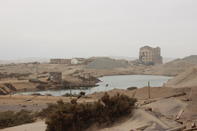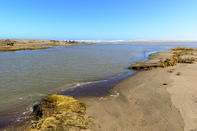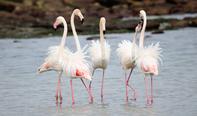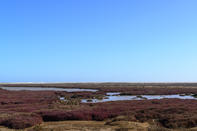A Utilitarian Town
Located at the mouth of the Orange River, Alexander Bay is a very typical company town. Built entirely by and for the state-owned Alexkor diamond mining operation, the town was once heavily restricted and you needed a permit to gain entry. Now, with the on-shore diamond mines almost exhausted, the town of Alexander Bay is a shadow of its former self and much more open to tourism.

So, all you need to do is stop at the boom gate, sign in, show your ID and they’ll let you right through. Once inside the settlement, it all looks very institutional. Rows of low brick houses vary in size, according to the status of the employees who live inside. There are several churches and schools in Alexander Bay, and several walls are painted with murals that are supposed to lighten the mood. But it’s a rather sombre place.
The tall wire fences that separates the town from the mining area along the beach are omnipresent, and ugly industrial structures seem to tower over everything. There’s no doubt that this was a utilitarian town with a one-track mind; nothing has been put here for beauty sake. It’s all very functional.
Orange River Mouth

The one attraction of Alexander Bay is the Orange River mouth. This vitally important RAMSAR wetland can be reached by following a series of hand painted signs (marked for ‘Riviermonding’) through the town and down a long sand road to a small parking area on the beach. On your left, the fence is covered with severe signs that say ‘Warning. Mine Area. No Entry’.
Behind the wire, you can see an enormous old mine building that is now abandoned and crumbling into the sand that is creeping up around its base. The lifeguard’s hut on the public part of the beach is similarly neglected and even the muddy ocean seems forlorn and angry. You now have to leave your car and walk along the beach to your right. It’s a wild scene, with long strands of seaweed and huge pieces of driftwood littering the blackened sand.
The actual river mouth is quite a distance away, but you can clamber up one of the sand dunes and get a good view out over the beautiful wetlands which stretch back from the narrow mouth.
They Don't Eat Diamonds

Birders to Alexander Bay, in particular, will do their nut. Thousands of Flamingos perch in the waters of the estuary (presumably they were allowed to stay because they don’t eat diamonds) and many other water birds wheel across the sky. In the distance, you can see the Boegoeberg twin mountains and, if you look carefully, you can just make out the town of Oranjemund in Namibia.
And if you’re a lover of lichen, don’t miss Lichen Hill. This little rise is covered with dozens of species of lichen and is the only one of its kind in South Africa. It’s located a short distance to the south of Alexander Bay, along the Port Nolloth road.
Natural Wonder

Unfortunately, there is no established visitor infrastructure that allows you to access the wetlands at Alexander Bay. You either have to organise a local guide who can unlock one of the gates in the fence, or find a good vantage point from the beach at Alexander Bay. The mouth has also been degraded by years of mining, but efforts are currently underway to rehabilitate this natural wonder. One hopes that improved tourist facilities are part of these plans.
Alexander Bay has a population of 1600 people, but only about 450 of these are permanent residents. Everyone else is here either on contract to the mine or stationed at the nearby navy base. It will be interesting to see what happens to the town of Alexander Bay, now that it has been given over to the Sida !Hub Communal Property Association (CPA).
By David Fleminger The town of Alexander Bay (Alexanderbaai in Afrikaans) in the Northern Cape, takes its name from Sir James Alexander, who dreamed of making ...
The town of Alexander Bay (Alexanderbaai in Afrikaans) in the Northern Cape, takes its name from Sir James Alexander, who dreamed of making ...